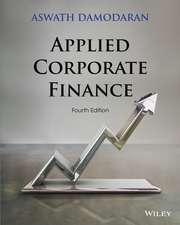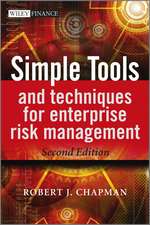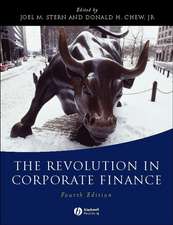Investment Valuation – Tools and Techniques for Determining the Value of any Asset, University Edition 3e
Autor A Damodaranen Limba Engleză Paperback – 19 apr 2012
The definitive source of information on all topics related to investment valuation tools and techniques Valuation is at the heart of any investment decision, whether that decision is buy, sell or hold. But the pricing of many assets has become a more complex task in modern markets, especially after the recent financial crisis. In order to be successful at this endeavor, you must have a firm understanding of the proper valuation techniques. One valuation book stands out as withstanding the test of time among students of financial markets and investors, Aswath Damodaran'sInvestment Valuation. Now completely revised and updated to reflect changing market conditions, this third edition comprehensively introduces students and investment professionals to the range of valuation models available and how to chose the right model for any given asset valuation scenario. This edition includes valuation techniques for a whole host of real options, start-up firms, unconventional assets, distressed companies and private equity, and real estate. All examples have been updated and new material has been added. * An expansion of ancillaries include updated online databases, spreadsheets, and other educational support tools * Fully revised to incorporate valuation lessons learned from the last five years, from the market crisis and emerging markets to new types of equity investments * Revised examples of company valuations such as companies from Eastern Europe and Africa, which stress the global nature of modern valuation * Author Aswath Damodaran is regarded as one of the best educators and thinkers on the topic of investment valuation This indispensable guide is a must read for students wishing to gain a better understanding of investment valuation and its methods. With it, you can take the insights and advice of a recognized authority on the valuation process and immediately put them to work for you.
Preț: 567.48 lei
Preț vechi: 616.83 lei
-8% Nou
108.60€ • 112.96$ • 89.66£
Carte disponibilă
Livrare economică 22 martie-05 aprilie
Specificații
ISBN-10: 1118130731
Pagini: 992
Dimensiuni: 178 x 251 x 36 mm
Greutate: 1.66 kg
Ediția:3rd Edition
Editura: JOHN WILEY & SONS INC
Locul publicării:Hoboken, United States
Public țintă
This edition is perfect for college students and their instructors.Cuprins
Chapter 1 Introduction to Valuation 1 A Philosophical Basis for Valuation 1 Generalities about Valuation 2 The Role of Valuation 6 Conclusion 9 Questions and Short Problems 9 Chapter 2 Approaches to Valuation 11 Discounted Cash Flow Valuation 11 Relative Valuation 19 Contingent Claim Valuation 23 Conclusion 25 Questions and Short Problems 25 Chapter 3 Understanding Financial Statements 27 The Basic Accounting Statements 27 Asset Measurement and Valuation 29 Measuring Financing Mix 36 Measuring Earnings and Profitability 42 Measuring Risk 47 Other Issues in Analyzing Financial Statements 53 Conclusion 55 Questions and Short Problems 55 Chapter 4 The Basics of Risk 58 What is Risk? 58 Equity Risk and Expected Return 59 Alternative Models for Equity Risk 71 A Comparative Analysis of Equity Risk Models 76 Models of Default Risk 77 Conclusion 81 Questions and Short Problems 82 Chapter 5 Option Pricing Theory and Models 87 Basics of Option Pricing 87 Determinants of Option Value 89 Option Pricing Models 90 Extensions of Option Pricing 107 Conclusion 109 Questions and Short Problems 109 Chapter 6 Market Efficiency--Definition, Tests, and Evidence 111 Market Efficiency and Investment Valuation 111 What Is an Efficient Market? 112 Implications of Market Efficiency 112 Necessary Conditions for Market Efficiency 114 Propositions about Market Efficiency 114 Testing Market Efficiency 116 Cardinal Sins in Testing Market Efficiency 120 Some Lesser Sins That Can Be a Problem 121 Evidence on Market Efficiency 122 Time Series Properties of Price Changes 122 Market Reaction to Information Events 130 Market Anomalies 134 Evidence on Insiders and Investment Professionals 142 Conclusion 149 Questions and Short Problems 150 Chapter 7 Riskless Rates and Risk Premiums 154 The Risk-Free Rate 154 Equity Risk Premium 159 Default Spreads on Bonds 177 Conclusion 180 Questions and Short Problems 180 Chapter 8 Estimating Risk Parameters and Costs of Financing 182 The Cost of Equity and Capital 182 Cost of Equity 183 From Cost of Equity to Cost of Capital 210 Best Practices at Firms 221 Conclusion 222 Questions and Short Problems 223 Chapter 9 Measuring Earnings 229 Accounting versus Financial Balance Sheets 229 Adjusting Earnings 230 Conclusion 247 Questions and Short Problems 249 Chapter 10 From Earnings to Cash Flows 250 The Tax Effect 250 Reinvestment Needs 258 Conclusion 268 Questions and Short Problems 269 Chapter 11 Estimating Growth 271 The Importance of Growth 272 Historical Growth 272 Analyst Estimates of Growth 282 Fundamental Determinants of Growth 285 Qualitative Aspects of Growth 301 Conclusion 302 Questions and Short Problems 302 Chapter 12 Closure in Valuation: Estimating Terminal Value 304 Closure in Valuation 304 The Survival Issue 318 Closing Thoughts on Terminal Value 320 Conclusion 321 Questions and Short Problems 321 Chapter 13 Dividend Discount Models 323 The General Model 323 Versions of the Model 324 Issues in Using the Dividend Discount Model 344 Tests of the Dividend Discount Model 345 Conclusion 348 Questions and Short Problems 349 Chapter 14 Free Cash Flow to Equity Discount Models 351 Measuring What Firms Can Return to Their Stockholders 351 FCFE Valuation Models 357 FCFE Valuation versus Dividend Discount Model Valuation 372 Conclusion 376 Questions and Short Problems 376 Chapter 15 Firm Valuation: Cost of Capital and Adjusted Present Value Approaches 380 Free Cash flow to the Firm 380 Firm Valuation: The Cost of Capital Approach 383 Firm Valuation: The Adjusted Present Value Approach 398 Effect of Leverage on Firm Value 402 Adjusted Present Value and Financial Leverage 415 Conclusion 419 Questions and Short Problems 419 Chapter 16 Estimating Equity Value per Share 423 Value of Nonoperating Assets 423 Firm Value and Equity Value 440 Management and Employee Options 442 Value per Share When Voting Rights Vary 448 Conclusion 450 Questions and Short Problems 451 Chapter 17 Fundamental Principles of Relative Valuation 453 Use of Relative Valuation 453 Standardized Values and Multiples 454 Four Basic Steps to Using Multiples 456 Reconciling Relative and Discounted Cash Flow Valuations 466 Conclusion 467 Questions and Short Problems 467 Chapter 18 Earnings Multiples 468 Price-Earnings Ratio 468 The PEG Ratio 487 Other Variants on the PE Ratio 497 Enterprise Value to EBITDA Multiple 500 Conclusion 508 Questions and Short Problems 508 Chapter 19 Book Value Multiples 511 Price-to-Book Equity 511 Applications of Price-Book Value Ratios 521 Use in Investment Strategies 530 Value-to-Book Ratios 532 Tobin's Q: Market Value/Replacement Cost 537 Conclusion 539 Questions and Short Problems 539 Chapter 20 Revenue Multiples and Sector-Specific Multiples 542 Revenue Multiples 542 Sector-Specific Multiples 571 Conclusion 577 Questions and Short Problems 577 Chapter 21 Valuing Financial Service Firms 581 Categories of Financial Service Firms 581 What is Unique about Financial Service Firms? 582 General Framework for Valuation 583 Discounted Cash Flow Valuation 584 Asset-Based Valuation 599 Relative Valuation 599 Issues in Valuing Financial Service Firms 605 Conclusion 607 Questions and Short Problems 608 Chapter 22 Valuing Firms with Negative or Abnormal Earnings 611 Negative Earnings: Consequences and Causes 611 Valuing Negative Earnings Firms 615 Conclusion 639 Questions and Short Problems 639 Chapter 23 Valuing Young or Start-Up Firms 643 Information Constraints 643 New Paradigms or Old Principles: A Life Cycle Perspective 644 Venture Capital Valuation 646 General Framework for Analysis 648 Value Drivers 659 Estimation Noise 661 Implications for Investors 662 Implications for Managers 663 The Expectations Game 663 Conclusion 665 Questions and Short Problems 666 Chapter 24 Valuing Private Firms 667 What Makes Private Firms Different? 667 Estimating Valuation Inputs at Private Firms 668 Valuation Motives and Value Estimates 688 Valuing Venture Capital and Private Equity Stakes 693 Relative Valuation of Private Businesses 695 Conclusion 699 Questions and Short Problems 699 Chapter 25 Aquisitions and Takeovers 702 Background on Acquisitions 702 Empirical Evidence on the Value Effects of Takeovers 705 Steps in an Acquisition 705 Takeover Valuation: Biases and Common Errors 724 Structuring the Acquisition 725 Analyzing Management and Leveraged Buyouts 730 Conclusion 734 Questions and Short Problems 735 Chapter 26 Valuing Real Estate 739 Real versus Financial Assets 739 Discounted Cash Flow Valuation 740 Comparable/Relative Valuation 759 Valuing Real Estate Businesses 761 Conclusion 763 Questions and Short Problems 763 Chapter 27 Valuing Other Assets 766 Cash-Flow-Producing Assets 766 Non-Cash-Flow-Producing Assets 775 Assets with Option Characteristics 777 Conclusion 778 Questions and Short Problems 779 Chapter 28 The Option to Delay and Valuation Implications 781 The Option to Delay a Project 781 Valuing a Patent 789 Natural Resource Options 796 Other Applications 802 Conclusion 802 Questions and Short Problems 803 Chapter 29 The Options to Expand and to Abandon: Valuation Implications 805 The Option to Expand 805 When Are Expansion Options Valuable? 812 Valuing a Firm with the Option to Expand 815 Value of Financial Flexibility 817 The Option to Abandon 820 Reconciling Net Present Value and Real Option Valuations 823 Conclusion 823 Questions and Short Problems 824 Chapter 30 Valuing Equity in Distressed Firms 826 Equity in Highly Levered Distressed Firms 826 Implications of Viewing Equity as an Option 828 Estimating the Value of Equity as an Option 831 Consequences for Decision Making 836 Conclusion 839 Questions and Short Problems 839 Chapter 31 Value Enhancement: A Discounted Cash Flow Valuation Framework 841 Value-Creating and Value-Neutral Actions 841 Ways of Increasing Value 842 Value Enhancement Chain 859 Closing Thoughts on Value Enhancement 864 Conclusion 865 Questions and Short Problems 865 Chapter 32 Value Enhancement: Economic Value Added, Cash Flow Return on Investment, and Other Tools 869 Economic Value Added 870 Cash Flow Return on Investment 884 A Postscript on Value Enhancement 890 Conclusion 891 Questions and Short Problems 891 Chapter 33 Probabilistic Approaches in Valuation: Scenario Analysis, Decision Trees, and Simulations 894 Scenario Analysis 894 Decision Trees 899 Simulations 908 An Overall Assessment of Probabilistic Risk-Assessment Approaches 919 Conclusion 921 Questions and Short Problems 921 Chapter 34 Overview and Conclusion 925 Choices in Valuation Models 925 Which Approach Should You Use? 926 Choosing the Right Discounted Cash Flow Model 929 Choosing the Right Relative Valuation Model 933 When Should You Use the Option Pricing Models? 937 Conclusion 938 References 939 Index 954
Notă biografică
ASWATH DAMODARAN is Professor of Finance at New York University's Leonard N. Stern School of Business. He has been the recipient of numerous awards for outstanding teaching, including the NYU university-wide Distinguished Teaching Award, and was named one of the nation's top business school teachers by BusinessWeek in 1994. In addition, Damodaran teaches training courses in corporate finance and valuation at many leading investment banks. His publications include Damodaran on Valuation: Security Analysis for Investment and Corporate Finance; Investment Valuation; Corporate Finance; Investment Management; and Applied Corporate Finance, all published by Wiley, and The Dark Side of Valuation.






















